Investigation on the Aerodynamic Performance of High-Pressure Cylinders under the Mode of Regulating Steam Supply with an Intermedium-Pressure Adjustment Valve
Abstract
:1. Introduction
2. Model Description
2.1. Modeling Methods
2.2. Simulation Conditions
3. Results and Discussion
3.1. Flow Field Analysis
3.2. Total-Total Isentropic Efficiency and Work Capacity
3.3. Blade Frequency and Strength
3.4. Control Strategy of High Discharge Pressure under Parameter Adjustment of the Intermedium-Pressure Adjustment Valve
4. Conclusions
Author Contributions
Funding
Conflicts of Interest
References
- Cui, Y.; Chen, Z.; Yan, G.G.; Tang, Y.H. Coordinated wind power accommodating dispatch model based on electric boiler and CHP with thermal energy storage. Proc. CSEE 2016, 36, 4072–4081. [Google Scholar]
- Deng, T.Y.; Tian, L.; Liu, J.Z. Thermal and electric load coupling analysis and decoupling coordinated control in heat supply units. J. Syst. Simul. 2017, 29, 2593–2599. [Google Scholar]
- Ju, W.P.; Lyu, K.; Ma, T.S.; Yang, R.Z.; Gu, W.W. Comparison of thermo-electric decoupling techniques for heating units. Therm. Power Gener. 2018, 47, 115–121. [Google Scholar]
- Ye, X.D.; Zhao, H.; Luo, F.Q. A Heating System and Method for Cutting Off the Intake Steam of the Low-Pressure Cylinder. China Patent CN107013262A, 26 May 2017. [Google Scholar]
- Xi, S.P. 200MW three-cylinder three-row steam turbine low-pressure cylinder “zero power” operation extracts steam for heating. China Plant Eng. 2018, 16, 125–126. [Google Scholar]
- Xi, S.P. Application of retrofit technology of optical axis and cylinder cutting in heating unit. Plant Maint. Eng. 2018, 17, 105–107. [Google Scholar]
- Deng, X.Y.; Yang, H.; Zhang, H.W. Numerical analysis of two-stage three-dimensional viscous flow field at the end of low-pressure cylinder of steam turbine under the condition of small flow rate. In Proceedings of the 2004 Conference on Aerodynamic Thermodynamics of Heat Engines of the Chinese Society of Engineering Thermophysics, Xi’an, China, 1 October 2004; pp. 263–268. [Google Scholar]
- Xin, Z.G. Study on reconstruction scheme and application of bypass heating for 320MW unit. Electr. Eng. 2022, 181–184. [Google Scholar] [CrossRef]
- Hu, K.; Chen, Q. Overall energy efficiency and flexibility retrofit scheme analysis of heat-power integrated energy system. Therm. Power Gener. 2018, 47, 14–21. [Google Scholar]
- Ruan, J.; Duan, W.Q. Test on adjustment characteristics of adjustment door in heat reheating of 1000M steam turbine. Power Oper. 2020, 10, 94–96, 144. [Google Scholar]
- Yuan, B.; Huang, S.W. Research on high-flow heating control strategy of 330MW units based on medium pressure combined with valves. Power Energy 2021, 42, 461–464. [Google Scholar]
- Madhavan, S.; Rajeev Jain, C.; Sujatha, A.S. Vibration based damage detection of rotor blades in a gas turbine engine. Eng. Fail. Anal. 2014, 46, 26–39. [Google Scholar] [CrossRef]
- Dutta, A.; Rama Rao, B.K. Blade vibration triggered by low load and high back pressure. Eng. Fail. Anal. 2014, 46, 40–48. [Google Scholar]
- Carrera, E.; Filippi, M.; Zappino, E. Free vibration analysis of rotating composite blades via Carrera Unified Formulation. Compos. Struct. 2013, 106, 317–325. [Google Scholar] [CrossRef]
- Lau, R.C.K.; Leung, R.M.C.; So, Y.L. Vortex-induced vibration effect on fatigue life estimate of turbine blades. J. Sound Vib. 2007, 307, 698–719. [Google Scholar] [CrossRef]
- Wagner, W.; Kretzschmar, H.J. International Steam Tables: Properties of Water and Steam Based on the Industrial Formulation IAPWS-IF97; Springer: Berlin/Heidelberg, Germany, 2008; pp. 7–150. [Google Scholar]
- Pennacchi, P.; Chatterton, S.; Bachschmid, N.; Pesatori, E.; Turozzi, G. A model to study the reduction of turbine blade vibration using the snubbing mechanism. Mech. Syst. Signal Process. 2010, 25, 1260–1275. [Google Scholar] [CrossRef] [Green Version]
- Li, J.J.; Xu, Y.H.; Wang, W.; Zhang, Y.H. Influence of turbulence model on numerical simulation of axial compressor. J. Nanchang Hangkong Univ. (Nat. Sci.) 2017, 31, 12–19. [Google Scholar]
- Liang, X.; Tian, Z.F. Combined compact upwind difference schemes for Navier-Stokes equations. Chin. J. Comput. Phys. 2008, 6, 659–667. [Google Scholar]
- Yamada, K.; Funazaki, K.; Furukawa, M. The behavior of tip clearance flow at near-stall condition in a transonic axial compressor rotor. In Proceedings of the ASME Turbo Expo 2007: Power for Land, Sea, and Air, Montreal, QC, Canada, 14–17 May 2007; Paper No. GT2007-27725. pp. 295–306. [Google Scholar]
- Zeng, X.Q.; Zhu, B.; Cai, H. Three-dimensional viscosity numerical simulation and performance comparison of two types of steam turbine low pressure cylinder final stages under small volume flow conditions. In Proceedings of the 2001 Conference on Aerodynamic Thermodynamics of Heat Engines of the Chinese Society of Engineering Thermophysics, Nanjing, China, 1 January 2001; p. 157. [Google Scholar]
- Wang, Z.B.; Ning, Z.; Zhao, Y.; Zhang, L.; Shi, Q. Testing and study of last stage flowing characteristics of dry cooling type 200MW steam turbine. Electr. Power 1997, 3, 41–43, 68. [Google Scholar]
- Zhu, X.C.; Wang, H.T.; Zhou, D.W. Numerical study of off-design on LP casing of steam turbine. Therm. Turbine 2008, 37, 51–53. [Google Scholar]
- Liu, J.J.; Cui, Y.Q.; Jiang, H.D. Investigation of flow in steam turbine exhaust hood with/without turbine exit conditions simulated. ASME J. Eng. Gas Turbines Power 2003, 125, 292–298. [Google Scholar] [CrossRef]
- Fu, J.L.; Zhou, S.J.; Liu, J.J. Experimental and numerical investigation of interactions between axial turbine and non-axisymmetric exhaust hood. In Proceedings of the ASME Turbo Expo 2008: Power for Land, Sea, and Air, Berlin, Germany, 9–13 June 2008; Paper No. GT2008-50766. pp. 1265–1278. [Google Scholar]
- Luis, T. New supersonic loss model for the preliminary design of transonic turbine blades and the influence of pitch. J. Turbomach. 2020, 142, 1–45. [Google Scholar]
- Rehman, A.; Liu, B.; Asghar, M.M. Secondary flow and endwall optimization of a transonic turbine. Energies 2019, 12, 4103. [Google Scholar] [CrossRef] [Green Version]
- Liu, C.; Geng, L.X.; Wang, H.; Miao, H.Q.; Shang, Z.B.; Zeng, L.F. Control strategy in transformation of high and low pressure bypass combined heat supply. Therm. Power Gener. 2020, 49, 126–132. [Google Scholar]
- Acosta-López, J.G.; Blasetti, A.P.; Lopez-Zamora, S.; de Lasa, H. CFD modeling of an H-Type Darrieus VAWT under high winds: The vorticity index and the imminent vortex separation condition. Processes 2023, 11, 644. [Google Scholar] [CrossRef]









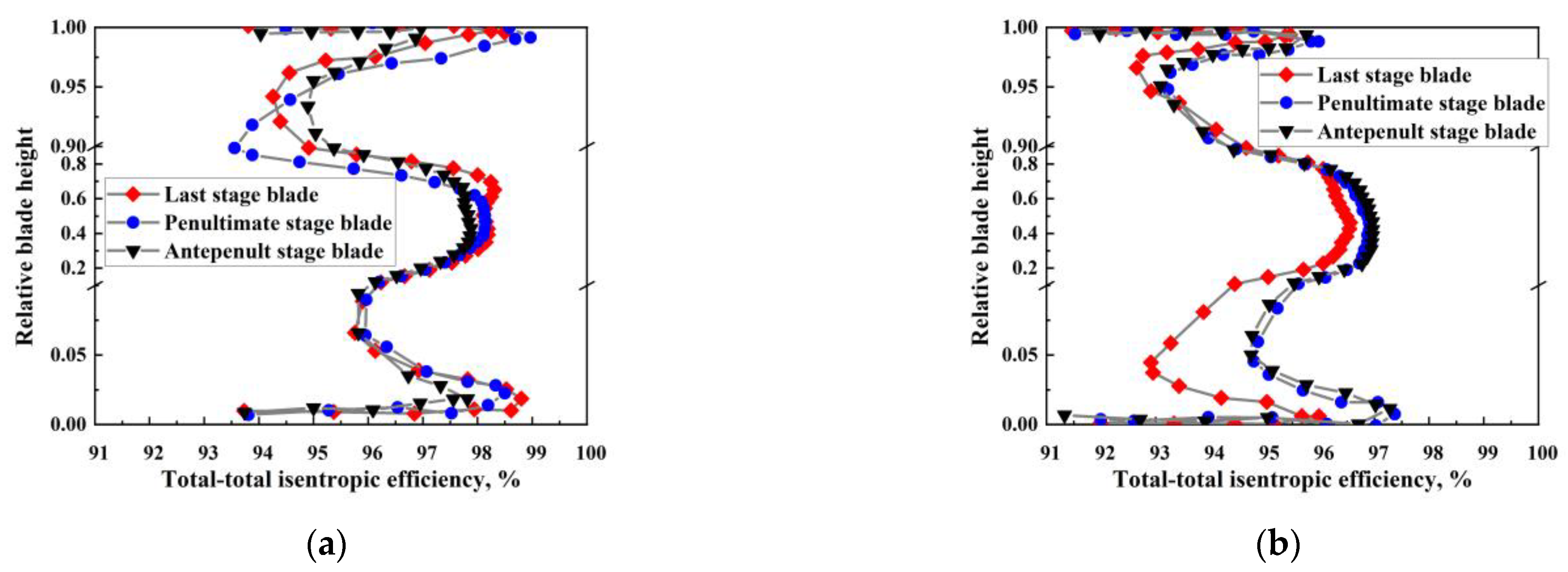
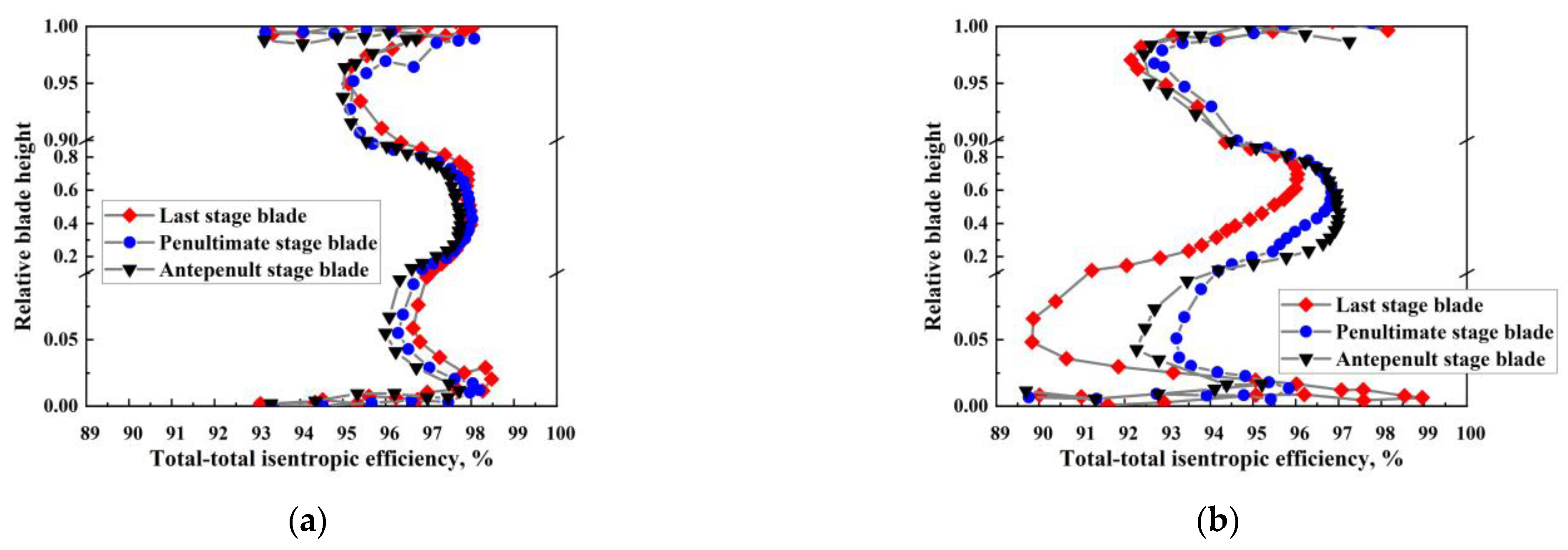


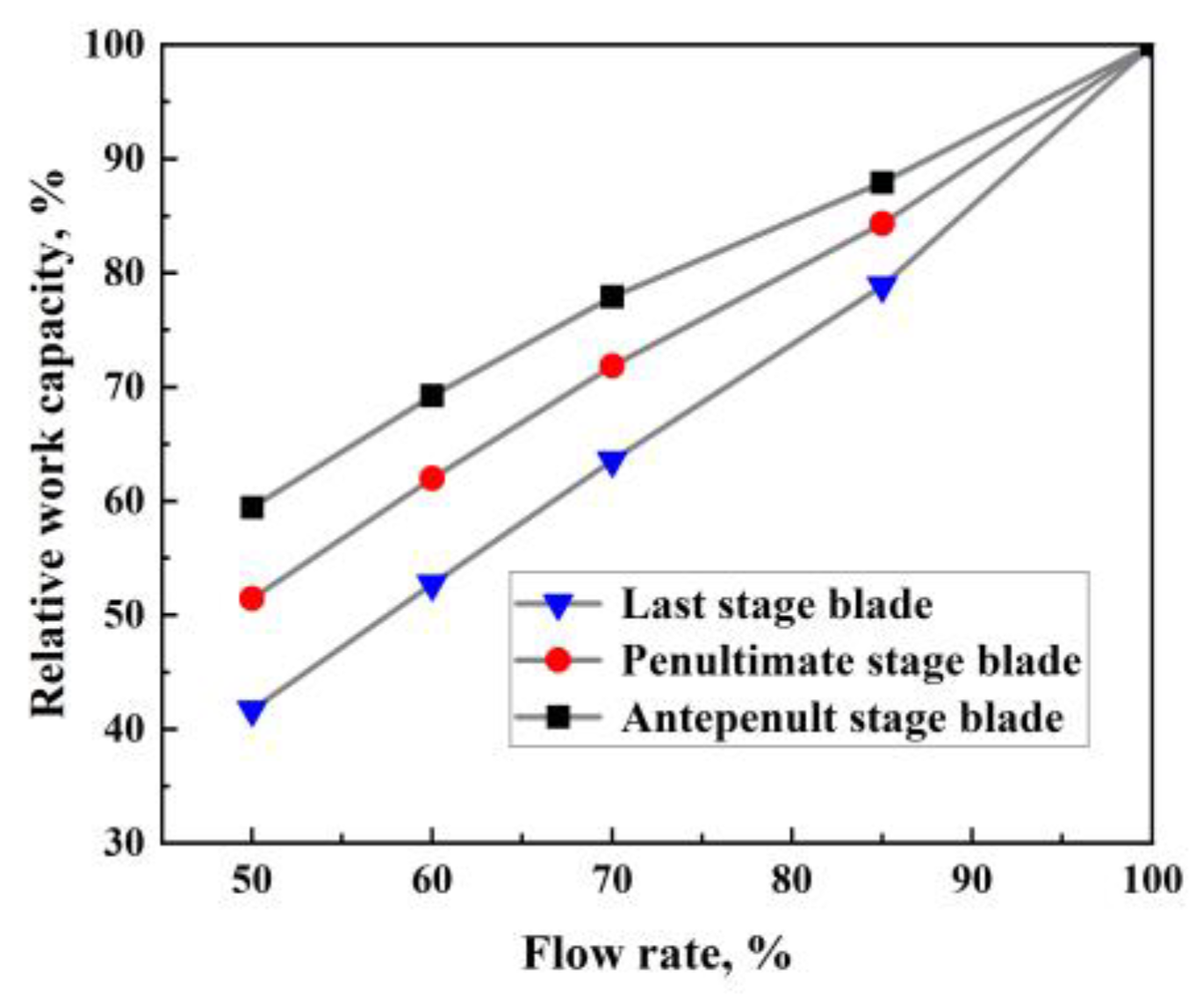
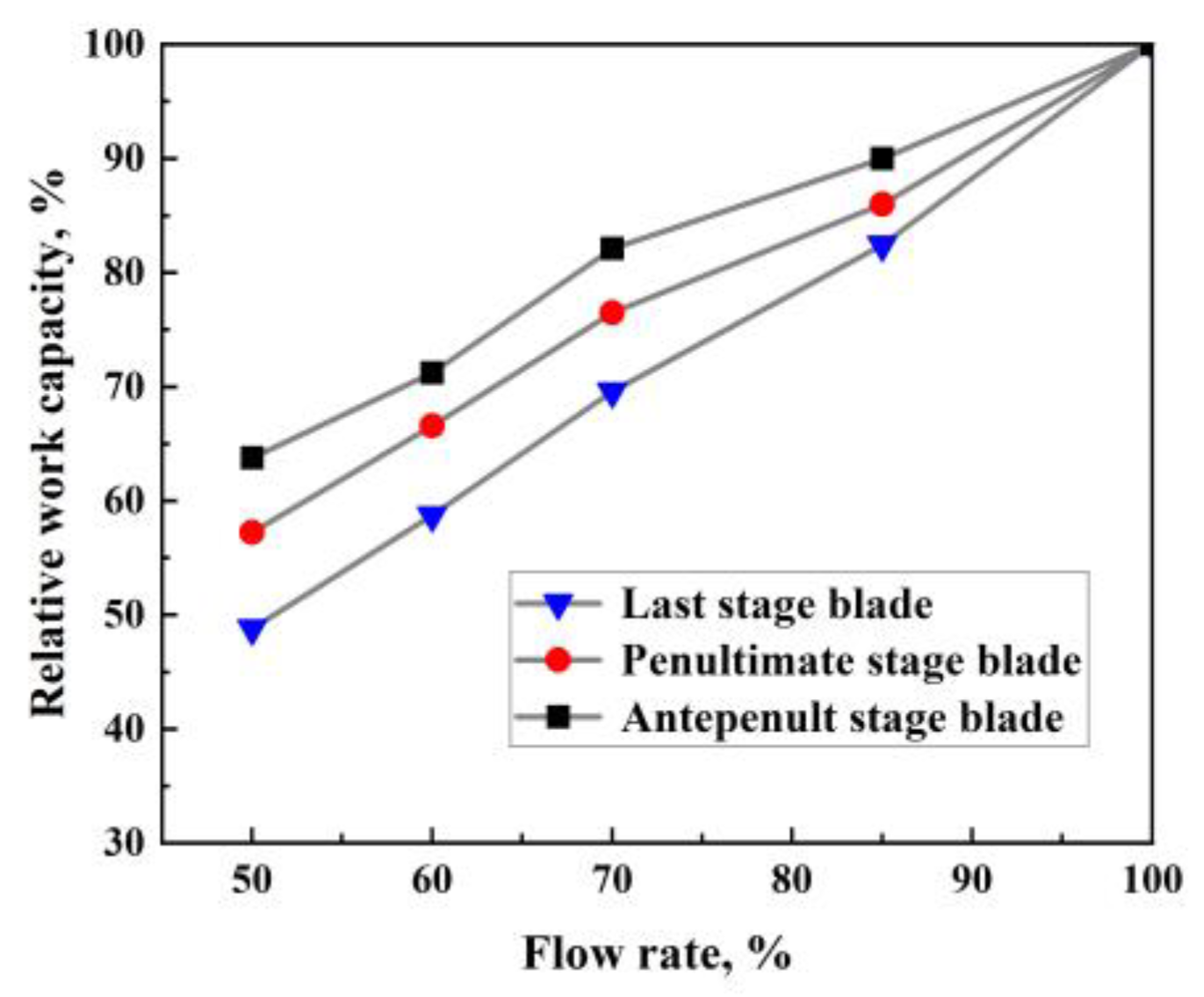


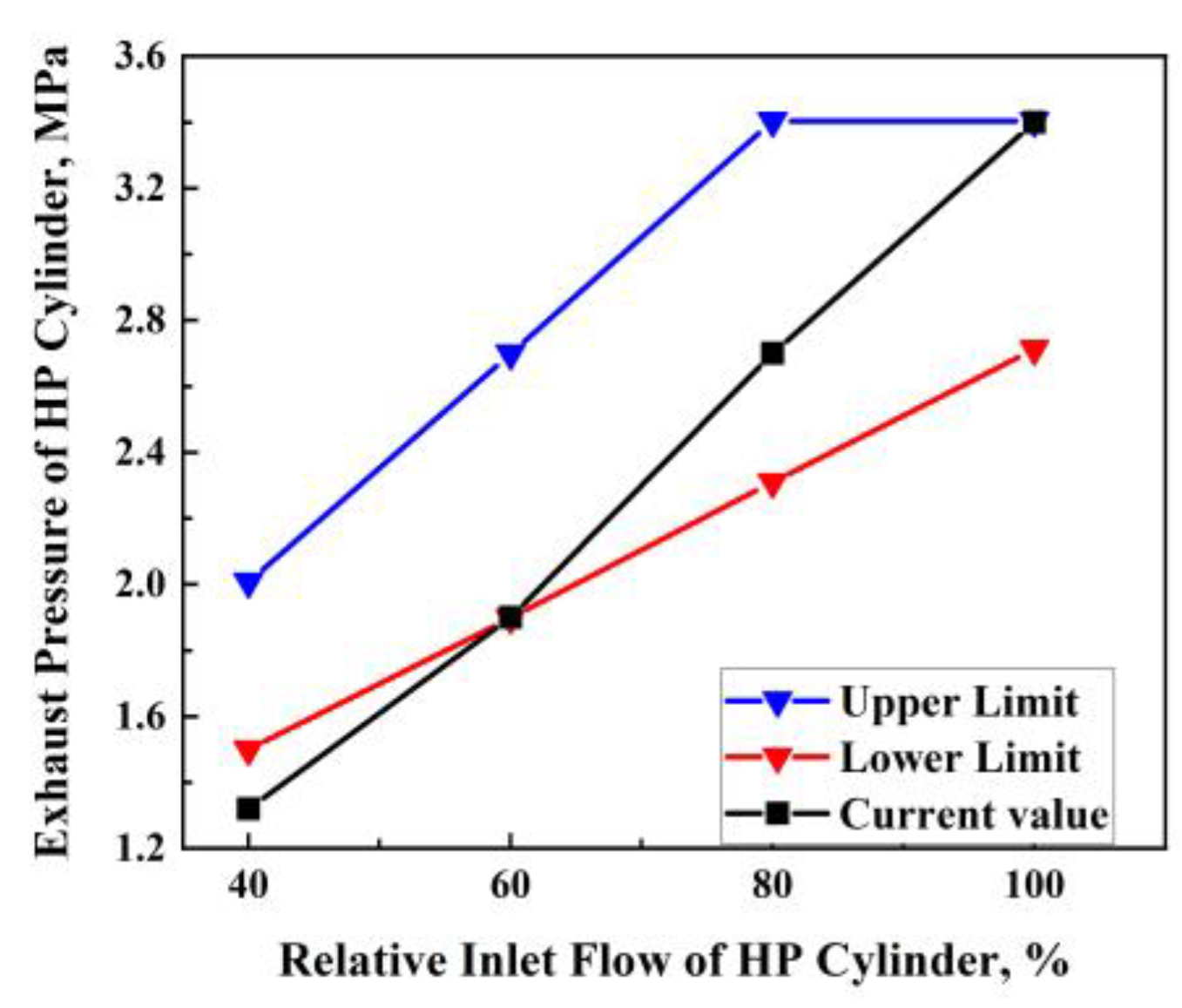
| (a) 3.4 MPa back pressure | |||||
| Load ratio/% | 100 | 85 | 70 | 60 | 50 |
| Inlet total pressure/MPa | 6.827 | 6.051 | 5.431 | 5.043 | 4.678 |
| Inlet total temperature/K | 677.45 | 673.85 | 688.05 | 697.15 | 709.85 |
| (b) 2.7 MPa back pressure | |||||
| Load ratio/% | 100 | 85 | 70 | 60 | 50 |
| Inlet total pressure/MPa | 6.375 | 5.574 | 4.935 | 4.529 | 4.143 |
| Inlet total temperature/K | 668.05 | 662.65 | 675.45 | 682.95 | 693.75 |
| (c) 1.9 MPa back pressure | |||||
| Load ratio/% | 85 | 70 | 60 | 50 | 40 |
| Inlet total pressure/MPa | 5.080 | 4.411 | 3.984 | 3.575 | 3.156 |
| Inlet total temperature/K | 650.35 | 660.95 | 666.35 | 674.75 | 682.15 |
Disclaimer/Publisher’s Note: The statements, opinions and data contained in all publications are solely those of the individual author(s) and contributor(s) and not of MDPI and/or the editor(s). MDPI and/or the editor(s) disclaim responsibility for any injury to people or property resulting from any ideas, methods, instructions or products referred to in the content. |
© 2023 by the authors. Licensee MDPI, Basel, Switzerland. This article is an open access article distributed under the terms and conditions of the Creative Commons Attribution (CC BY) license (https://creativecommons.org/licenses/by/4.0/).
Share and Cite
Zhang, P.; Ke, X.; Wang, W.; Tang, Q.; Liu, X.; Lyu, J.; Tang, X. Investigation on the Aerodynamic Performance of High-Pressure Cylinders under the Mode of Regulating Steam Supply with an Intermedium-Pressure Adjustment Valve. Processes 2023, 11, 1214. https://doi.org/10.3390/pr11041214
Zhang P, Ke X, Wang W, Tang Q, Liu X, Lyu J, Tang X. Investigation on the Aerodynamic Performance of High-Pressure Cylinders under the Mode of Regulating Steam Supply with an Intermedium-Pressure Adjustment Valve. Processes. 2023; 11(4):1214. https://doi.org/10.3390/pr11041214
Chicago/Turabian StyleZhang, Pan, Xiwei Ke, Weiliang Wang, Qinghong Tang, Xiong Liu, Junfu Lyu, and Xueyu Tang. 2023. "Investigation on the Aerodynamic Performance of High-Pressure Cylinders under the Mode of Regulating Steam Supply with an Intermedium-Pressure Adjustment Valve" Processes 11, no. 4: 1214. https://doi.org/10.3390/pr11041214





